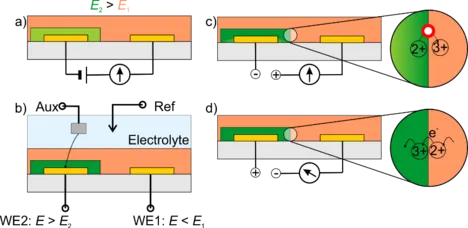Multi-layer Thin Films of Metal Hexacyanometallates
metal hexacyanometallates • thin film • wet process • electrochemistry • characterization
L. Harms(a), G. Wittstock(a)
(a) School for Mathematics and Science, Department of Chemistry, Carl v. Ossietzky University of Oldenburg, Ammerlaender Heerstraße 114-118, 26111 Oldenburg, Germany
Metal hexacyanometallates (M-HCM) are an interesting class of coordination materials, which can exhibit electronic and ionic conductivity. Prussian Blue (ferric hexacyanoferrate, Fe-HCF) is probably the best-known representative of this materials.[1-3] M-HCMs contain one or more transition metal centres connected via cyanide ligands (CN-). The metal centres can exhibit mixed valence character as for example in Fe-HCF. In the case of Fe-HCF, these are low-spin Fe2+, which is C-coordinated and high-spin Fe3+, which is N-coordinated. The charge of the material can be balanced by alkali metal ions (or NH4+) which can move in the channels of the cubic structure. This provides ionic conductivity. Well defined redox transitions are enabled by switching the redox state of the transition metal ion and concomitantly take up or release an alkali metal ion to balance the overall charge.
Our aim is to produce stacked multi-layers of different M-HCM films and to study the redox switching behaviour of such multilayer architectures.[4] In this way, electrical transport properties can be controlled and a directional charge transport can be created by arranging the layers in the sequence of the redox potential of the metal centres.
In this work, the thin multi-layer M-HCM films are produced by combining different deposition techniques based on chemical and electrochemical approaches.[5] Different analytical methods are used to investigate the properties of the individual films as well as the interaction of the layers with each other. X-ray diffraction is used to analyze the crystallinity of the solids, whereas X-ray photoelectron spectroscopy examines the chemical compositions (content of mobile alkali cations) and the redox state of the transition metal centers. Cyclic voltammetry is used to investigate electrochemical properties. Since the homogeneity of the films plays an important role, microscopic methods are indispensable tools for analysis. Atomic force microscopy and scanning electron microscopy are used to study the morphology of the deposited materials and shall also be used to characterize multilayer architectures mechanically and electronically.
References
[1] F. Grandjean, L. Samain, G. J. Long, Dalton Trans. 2016, 45, 18018-18044.
[2] K. R. Dunbar, R. A. Heintz, in Progress in Inorganic Chemistry, Vol. 45 (Ed.: K. D. Karlin), John Wiley & Sons, Inc., Hoboken, NJ, 1997, pp. 283-392.
[3] A. A. Karyakin, Electroanalysis 2001, 13, 813-819.
[4] K. Ono, M. Ishizaki, S. Soma, K. Kanaizuka, T. Togashi, M. Kurihara, RSC Adv. 2015, 5, 96297-96304.
[5] P. Hosseini, K. Wolkersdörfer, M. Wark, E. Redel, H. Baumgart, G. Wittstock, J. Phys. Chem. C 2020, 124, 16849-16859.
Interested in finding out more? Click here to learn more about this overarching COORNETs Phase II team and project.
